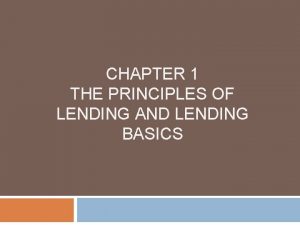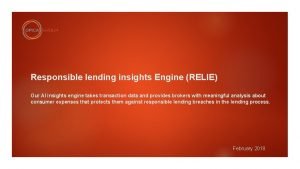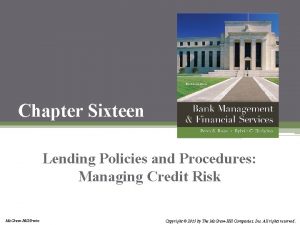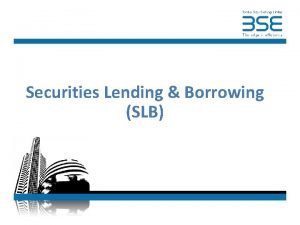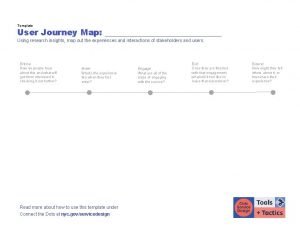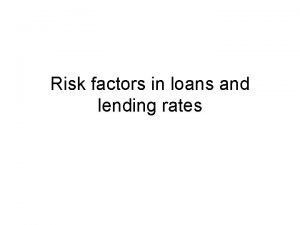CHAPTER 1 THE PRINCIPLES OF LENDING AND LENDING


































- Slides: 34

CHAPTER 1 THE PRINCIPLES OF LENDING AND LENDING BASICS

Learning objectives Identify the basic principles governing bank lending and explain their importance Understand the framework within which credit and lending decisions are taken Understand the Credit Process Explain the characteristics of various types of bank advance Distinguish different types of borrowers and the special considerations that apply to them when giving loans Explain how advances are structured Explain the importance of credit culture in a lending institution Understand how an advance portfolio is designed

The principles of good lending Safety of Loan: This principle requires that a loan is granted to only that borrower who is considered safe, i. e. a one who is of good character Suitability of loan Loans must be given for any valid purpose, i. e. a one that is legal and conforms to the lending policy of the bank Profitability Banks are in the business of lending to earn profits, so they will compare the cost and benefit of a loan before granting a loan. Following the lending principles – Credit analysis can be done by traditional or modern methods

Traditional methods of credit analysis Any credit analysis is concerned with the measurement of credit risk. The traditional method of assessment is done using the following criteria known as the 5 Cs: 1 - Character 2 - Capacity 3 - Capital 4 - Collateral 5 - Conditions

Traditional methods of credit analysis Five key questions/issues: 1. What is the character of the borrower and the quality of information provided? 2. What are the loan proceeds going to be used for? 3. How much does the customer need to borrow? 4. What is the primary source of repayment and when? 5. What collateral is available ? (Secondary source of repayment)

Traditional methods of credit analysis The 5 Cs: Character: It involves collecting information about the borrower’s track record of integrity, repayment ability and spending habits, i. e. what is the trust worthiness of the borrower Capacity: is the ability to repay the loan together with interest as per the pre -determined schedule (this is the financial capacity). Capital: It refers to the capital contribution that the borrower proposes to make in the total investment (this establishes the owner’s stake in the project and therefore, the higher the owner’s stake the more confident the lender is) Collateral: Also known as the secondary source of repayment. It is a sort of a guarantee (security that the lender takes possession of and use it in case of default) Condition: The analysis of condition covers external and internal factors. The external conditions include the condition of the economy, the relevant industry, etc. The internal conditions include, lending policies, budget, staff, etc.

Other approaches to credit analysis The 5 C’s approach is the traditional approach to credit risk measurement. There are modern approaches that measure credit risk with the help of statistical methods and technology. Subsequent chapters will outline details of these modern approaches. However, it must be noted that it is hard to draw the line between traditional and new approaches. This is because many of the traditional models are used in the new models.

Other approaches to credit analysis Other categories of traditional approaches include: Rating Systems � � � There are many rating agencies such as Moody’s or Standard & Poor’s that exist in the Capital Markets. There also Bond rating terminologies, such as AAA, A+ or B, etc. The rating or codes are given on a 10 -point scale. A rating of 1 denotes excellent business credit, superior asset quality, excellent debt capacity and coverage, etc. A rating of 4 may mean an acceptable credit but with more than average risk. A rating of 8 may mean unacceptable business credit where even normal repayment could be in jeopardy. Credit Scoring System: � � � These systems identify and weigh (on a quantitative scale) certain key factors that determine the probability of repayment default The higher the score, the better is the loan quality and the lower is the risk Pre determined points are allocated for factors such as a stable job, own home, etc.

Modern approaches to credit analysis The more commonly used modern approaches include the following: Econometric techniques – involves the modeling of the probability of default Optimization models – use mathematical programming techniques to minimize lender errors and thus maximize profits Neural networks – try to emulate the human decision making process using data as used in econometric techniques. Hybrid systems – Involves establishing causal relationships by estimating parameters of such relationships.

A Framework for credit and lending Process 5 Cs of lending Borrower Specific Factors Internal Factors External Factors Reserve Act Consumer Act Strategic Considerations Lending Policy Loan Portfolio Design Uniform Consumer Credit Code General Law

External Factors General Law : Institutions cannot lend for an unlawful activity (Cannot lend for illegal purpose) Macroeconomic factors: The conditions of the economy affects the lending decisions. Industry-specific factors: While the economy may be in good shape, a particular industry may be in trouble, so firms must take particular care with a loan for firms in that industry. The reserve bank act and the banking act: Central banks have the power to step and issue suitable directions to regulate the reserves and other various provisions that have impacts on the lending decisions. Uniform Consumer Credit Code: Lending officers have to comply with the provisions of the consumer credit code (will be explained in another chapter)

Lending institutions specific factors (internal factors) The lending policy of the institution: All advances have to comply with the lending policy of the lending institution The loan budget: lending firms have a lending budget which they must observe, i. e. in case fund shortages they may restrict lending Staff availability: Lending institutions may restrict the lending if they are shortage of skilled staff who will appraise and monitor loans Once a loan request satisfies the requirements of the various issues related to the external and internal factors, then borrower specific factors need to be considered.

Borrower Specific Factors They refer o the 5 Cs The lending officer examines the character of the prospective borrower from various sources The capital (owner’s stake in the proposed investment) that the borrower is prepared to make The capacity to repay The conditions of the loan The collateral in case of non repayment of the loan

The Credit Process

The Credit Process Loan Policy � Formalizes lending guidelines that employees follow to conduct bank business Credit Philosophy � Management’s philosophy that determines how much risk the bank will take and in what form Credit Culture � The fundamental principles that drive lending activity and how management analyzes risk

The Credit Process Credit Culture � The fundamental principles that drive lending activity and how management analyzes risk � Values Driven Focus is on credit quality � Current-Profit Focus is on short-term earnings � Market-Share Focus Driven is on having the highest market share

Business Development and Credit Analysis Business Development � Market research � Train employees: On what products are available What products customers are likely to need How they should communicate with customers about those needs � Advertising and Public Relations � Officer Call Programs

Business Development and Credit Analysis � Evaluate a borrower’s ability and willingness to repay � Questions to address What risks are inherent in the operations of the business? What have managers done or failed to do in mitigating those risks? How can a lender structure and control its own risks in supplying funds?

Credit Execution and Administration Loan Decision � Individual officer decision � Committee � Centralized underwriting Loan Agreement � Formalizes the purpose of the loan � Terms of the loan � Repayment schedule � Collateral required � Any loan covenants � States what conditions bring about a default

Credit Execution and Administration Documentation: Perfecting the Security Interest � Perfected When the bank's claim is superior to that of other creditors and the borrower Require the borrower to sign a security agreement that assigns the qualifying collateral to the bank Bank obtains title to equipment or vehicles

Credit Execution and Administration Position Limits � Maximum allowable credit exposures to any single borrower, industry, or geographic local Risk Rating Loans � Evaluating characteristics of the borrower and loan to assess the likelihood of default and the amount of loss in the event of default

Credit Execution and Administration Loan Covenants � Lenders may impose additional covenants to ensure added protection. Some covenants are regarded as negative and others are regarded as positive � Positive (Affirmative) Indicate specific provisions to which the borrower must adhere � Negative Indicate financial limitations and prohibited events

Sample of Loan Covenants

Characteristics of different types of advances Advances can be classified into traditional and modern types

Traditional types of advances Loans: The entire loan is given to the borrower in one lump sum. The loan (principal) together with the interest must be repaid over a fixed period of time 1 - Loans are classified according to security, i. e. secured or unsecured loans 2 - Loans are classified according to type of borrower, i. e. personal or business loans 3 - Loans classified according to the term of the loan, i. e. short term or long term loans 4 - Loans classified according to sector, i. e. retail, manufacturing, etc. The sectorization helps the regulators to see how credit is flowing in different sectors. 5 - Loans are classified according to region: Regulatory authority may also be concerned about the flow of credit in the different regions of the country.

Traditional types of advances Overdrafts: This is like running account, where there are no lump sum payments nor a repayment in installments over a period of time. The borrower Overdraft facilities are only allowed for current accounts An Overdraft is a fluctuating account, i. e. sometimes it is in credit and in other times it could be in debit Like Loans, Overdrafts can also be classified according to security, borrower, sector, etc. Credit cards are special forms of overdraft and they provide consumers with a means of obtaining credit if required

Modern types Equity Participation: Lending institutions supply equity capital to satisfy the long term financing needs of large businesses. Loan Syndication: involves two or more lenders jointly meeting the large financial needs of a corporate customer. It may be difficult for one single lender to meet the requirement of a very large company. Equipment leasing: A lease is a contract under which the lessor (lender) hires out specific equipment to a lessee (borrower). Factoring: it is the purchase of debts by institutions. The lender purchase the trade debts of a business (at a discount) and pays the business in cash

Different Types of Borrowers Minors: This is a person who has not yet reached the age of 18, consequently he should not be granted a loan. A minor cannot be compelled to repay the money that he/she borrowed. Persons of unsound mind: If a person of unsound mind can prove that he/she was so at the time of entering into a loan contract, then the liability under the contract can be avoided. Insolvents: A financial institution should not lend to an undischarged insolvent or a person against whom insolvency proceedings are pending Joint Account: A joint account is a bank account conducted in the names of two or more persons who are not partners Husband wife: The rights and responsibilities of husband wife are similar to those of other joint account holders.

Business Borrowers There are different forms of business and hence different types of business borrowers Sole Proprietorship: is a business that an individual owner conducts in his/her name or a trade name Partnership: is a relation between persons who have agreed to share the profits of a business carried on by all or any one of them acting for all. Companies: is an artificial person created by law, consequently it needs some natural person to act on its behalf. Lenders must make sure that there is a resolution by the BOD to borrow and the borrowing is within the borrowing powers of the company.

Special types of borrower The special types of borrowers are not individuals or business. They are: Local Authorities: Can be a council of a city created to govern the borrowing power. Lenders need to examine the extent to which the authority can borrow. Clubs, Schools: These have no legal entity like a company and have no power to enter into contractual relations. Such organizations usually register as unincorporated associations. Lenders are therefore, requested to examine the bylaws of such organizations. Unincorporated association: These are charity organizations and therefore, lenders should take precautions (same as for clubs) Co-operatives: organizations established for the benefit of members Must be treated in similar manner to clubs and unincorporated organizations.

Structuring of advances It involves three major aspects: Obtaining security, deciding on the debt covenants and pricing Security: There are different types of securities, each of which is having its own documentations. They include: - Land - Guarantees obtained from company directors - For personal borrowers, an equitable mortgage over assets

Perfecting the Security Interest The security is said to be perfected, when the bank's claim is superior to that of other creditors and the borrower Require the borrower to sign a security agreement that assigns the qualifying collateral to the bank Bank obtains title to equipment or vehicles

Pricing issue These include the interest rates and fees to be charged on advances. Most lenders have a rate base to which they add a margin (risk premium). Lenders generally charge the following fees: - establishing fee (commitment fee) - Application fee - loan administration fee - unused limit fee

Designing advances Portfolio Loans represent more than 70% of total assets of a typical financial institution, therefore, top management & portfolio managers’ major task is to design loan portfolios. The strategic decisions of these managers, when making portfolio selections include the following: - What resources are available to invest? - What proportion of these resources should be invested in advances? - What proportion of these advances will be invested in personal loans and what proportion for business loans? The designing of the loan portfolio s about finding answers to the above questions.
 The principles of sound lending
The principles of sound lending Principles of lending
Principles of lending Basic principles of lending
Basic principles of lending Relie responsible lending and insights engine
Relie responsible lending and insights engine An institution for receiving keeping and lending money
An institution for receiving keeping and lending money Lending policies and procedures managing credit risk
Lending policies and procedures managing credit risk Securities lending and borrowing example
Securities lending and borrowing example Queensbridge map
Queensbridge map Relie responsible lending and insights engine
Relie responsible lending and insights engine Relie responsible lending and insights engine
Relie responsible lending and insights engine Relie responsible lending and insights engine
Relie responsible lending and insights engine Relie responsible lending and insights engine
Relie responsible lending and insights engine Hình ảnh bộ gõ cơ thể búng tay
Hình ảnh bộ gõ cơ thể búng tay Frameset trong html5
Frameset trong html5 Bổ thể
Bổ thể Tỉ lệ cơ thể trẻ em
Tỉ lệ cơ thể trẻ em Chó sói
Chó sói Thang điểm glasgow
Thang điểm glasgow Hát lên người ơi alleluia
Hát lên người ơi alleluia Môn thể thao bắt đầu bằng từ chạy
Môn thể thao bắt đầu bằng từ chạy Thế nào là hệ số cao nhất
Thế nào là hệ số cao nhất Các châu lục và đại dương trên thế giới
Các châu lục và đại dương trên thế giới Công của trọng lực
Công của trọng lực Trời xanh đây là của chúng ta thể thơ
Trời xanh đây là của chúng ta thể thơ Cách giải mật thư tọa độ
Cách giải mật thư tọa độ 101012 bằng
101012 bằng Phản ứng thế ankan
Phản ứng thế ankan Các châu lục và đại dương trên thế giới
Các châu lục và đại dương trên thế giới Thơ thất ngôn tứ tuyệt đường luật
Thơ thất ngôn tứ tuyệt đường luật Quá trình desamine hóa có thể tạo ra
Quá trình desamine hóa có thể tạo ra Một số thể thơ truyền thống
Một số thể thơ truyền thống Cái miệng nó xinh thế
Cái miệng nó xinh thế Vẽ hình chiếu vuông góc của vật thể sau
Vẽ hình chiếu vuông góc của vật thể sau Thế nào là sự mỏi cơ
Thế nào là sự mỏi cơ đặc điểm cơ thể của người tối cổ
đặc điểm cơ thể của người tối cổ


